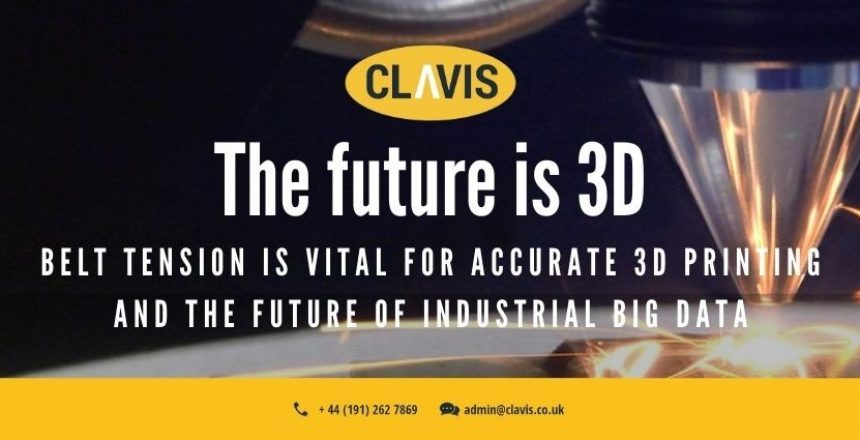3D printing hasn’t quite taken over industry, just yet, but new advancements each year — with metal powders, for instance — point to a future where the technology’s use will be widespread. But are you aware how important correct belt tension is to achieving an accurate 3D print? Here, I explain why belt measurement technologies are critical for this exciting tech.
Analysts predict real growth in the 3D printers market, and reckon it will be worth $32.78 billion by 2023. Because Clavis frequently works with customers, original equipment manufacturers (OEMs) or integrators at the pre-production design phase, we are increasingly seeing 3D printing factor into our own projects.
We normally work from sample units or pre-production parts and computer aided design (CAD) files in the early design stages, which proved to be especially productive with a customer in the US. The customer had a unique requirement for its belt tension setting equipment, which needed to accommodate a coolant tank. At Clavis, we design bespoke optical sensor head units for many applications — but the presence of a cooling tank made the project a lot more challenging!
Ideally, we would ship a prototype of the new optical sensor head design over to the US, so the customer can drop it into their production set-up and test it out before we deliver the final product. But, with the customer in North America, and Clavis in Newcastle upon Tyne, UK, we needed to find a way more cost and time-efficient delivery method. Fortunately, the customer had a 3D printer.
“Problems that arise from a wrongly tensioned 3D printer belt are the same as other applications like automobiles or agricultural equipment — wear, unexpected maintenance and downtime.”
All we had to do was send over our CAD designs. Using a STEP file of our bespoke-designed optical sensor head mounting unit, the customer could physically drop the 3D printed plastic prototype into their production line, get a feel for it, and then proceed with our design with confidence. This was before we had even manufactured a physical aluminium prototype, ourselves.
So, there are real opportunities for time and cost savings with 3D printing — despite the initial cost of the 3D printer itself — not to mention improved opportunities for remote working in this era of restricted travel and COVID-19. But have you considered the importance of accurate belt measurement with 3D printing? Most large volume plastic 3D printers rely on a belt, while some machines designed for the mass production 3D printing of metal parts also rely on a conveyor belt.
Accuracy is crucial for obtaining good 3D printed results. If something comes loose mid-print, or doesn’t move exactly the way it should, the effects will be clearly visible in the final printed component. So, with a 3D printer belt, it’s very important to make sure that its movements are as controlled and accurate as possible.
The problems that arise from a wrongly tensioned belt in a 3D printer are largely the same as in other applications, be it automobiles or agricultural equipment. They include issues of wear, significantly shortened lifetime of the belt and unexpected maintenance and downtime.
Whatever the application, it’s all about the efficiency, power and lifetime of the belt. The 3D printers of today and tomorrow also require flexible measurement systems that can reach into the nooks and crannies. In addition, the belt measurement system might be required to fit in with an automated system, for instance, or be compatible with a moveable robotic arm.
For this, an answer lies in Clavis’s Fourier measurement system, which monitors the tension of the drive belt using an optical sensor head. Most electrically assisted power steering (EPAS) systems in vehicles are already measured with the Fourier and our specialists can support our customers at the pre-production design phase.
But the advantages of the Fourier also extend to data use. The whole world is becoming more data driven, and 3D printing will be integral to industry’s continued evolution towards smart factories, Industry 4.0 and big data. At Clavis, we’ve certainly seen this among our own customer base over the last 15 to 20 years.
Today’s manufacturers want to know absolutely everything through data about how the equipment in their factories performs. That should include the frequency or tension a belt is operating at, in real-time, so each 3D print can be assessed within minutes, before moving on to the next one. A system like the Fourier can be crucial in communicating this data to human machine interfaces (HMIs) on the shop floor.
Clavis has already put this concept to the test for one customer, a well-known multinational tech company and computer manufacturer in Singapore. The company found Clavis through our website, and opted to use the Fourier in its own 3D printing system. For this, a key capability of the Fourier was its Bluetooth compatibility, making belt measurement integral to manufacturers’ data requirements.
“The whole world is becoming more data driven, and 3D printing will be integral to industry’s continued evolution towards smart factories, Industry 4.0 and big data.”
3D printing hasn’t yet taken over industry but, who knows, perhaps one day it will do. With Clavis’s products and expertise, the right belt measurement systems can be in place to support accuracy and data monitoring in tomorrow’s 3D prints.
Article by Mark Errington

